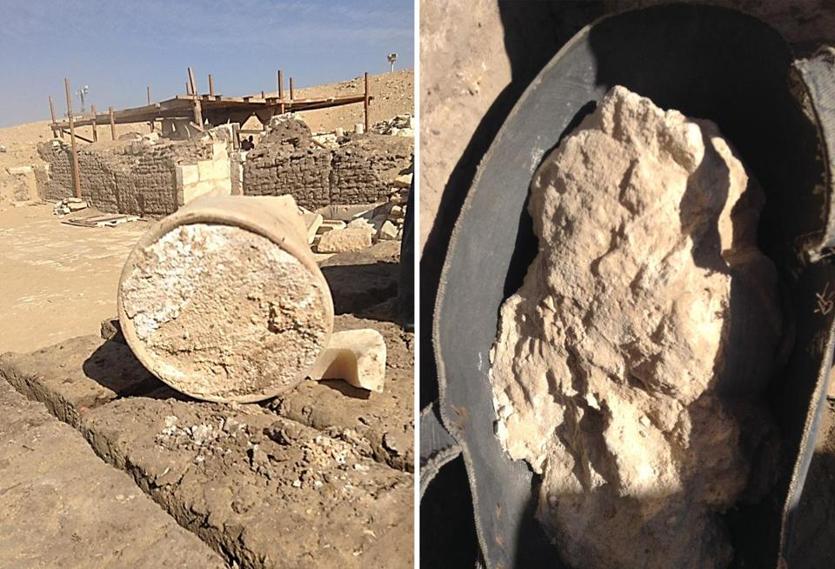It looks like you're using an Ad Blocker.
Please white-list or disable AboveTopSecret.com in your ad-blocking tool.
Thank you.
Some features of ATS will be disabled while you continue to use an ad-blocker.
share:
a reply to: toms54
Yes. It is in the NY Times also with that same photo.
Archaeologists Find 3,200-Year-Old Cheese in an Egyptian Tomb
Google News with many sources:
Go ogle News
Yes. It is in the NY Times also with that same photo.
Archaeologists Find 3,200-Year-Old Cheese in an Egyptian Tomb
Google News with many sources:
Go ogle News
a reply to: SailorJerry
Just like you're doing with me right now... My first comment was right on target with the thread. Seems you just completely ignored that tho.
Just like you're doing with me right now... My first comment was right on target with the thread. Seems you just completely ignored that tho.
originally posted by: Byrd
originally posted by: toms54
Anyway, the caption says "Reuters." Since the wire service is credited, I assume they got both the story and picture from them.
That means the photo is from Reuters. The article is not a Reuters article.
Considering that the Google News link I posted contains about 40 sources, many with the same picture, most of them newspapers, all at the same time, I would say odds are good it came from some wire service.
originally posted by: toms54
originally posted by: Harte
originally posted by: toms54
a reply to: Byrd
I wouldn't say RT is as good a source as a respected scientific journal. For general news it's as good a source as CNN. It really depends on the topic for any source.
So you don't care that they showed the bottom of a column in their "cheese" pic?
Harte
I would have preferred to see an actual photo of the subject of the article. That said, it's not like I haven't seen this before in any number of popular articles. They don't have a suitable picture so they put up something they feel is representative. Or maybe some art.
The thing about this was the caption, "The 3,200-year-old cheese © University of Catania - University of Cairo / Reuters" To tell the truth, I don't know a column from cheese. I believed it. The only reason I believe you now is because I have seen you post about archeology so I believe you probably know the difference.
Dude, I only glanced at it until Byrd said it was a column. I thought it was a wheel of cheese at first glance.
I mean, why not? It's not as if it's unbelievable.
I only closely scrutinize stuff that seems unbelievable (and it's almost always not true.)
It does bother me though that they threw up a pic of the end of a column.
Harte
originally posted by: toms54
a reply to: Harte
I took a quick look for other sources. There is an abstract with no pictures at pubs.acs.org... Others news sources seem to have the exact same picture. Here's the one from The Boston Globe:
Now that’s some aged cheese: Researchers say world’s oldest known solid cheese found in an Egyptian tomb
That caption says, "University of Catania and Cairo University via The New York Times" so the photo must be in The New York Times also. Starting to look like it's legit.
I don't know, man.
Those two pics look different to me. LOL
Maybe the column is at the site near where the cheese was found.
Harte
originally posted by: toms54
originally posted by: Byrd
originally posted by: toms54
Anyway, the caption says "Reuters." Since the wire service is credited, I assume they got both the story and picture from them.
That means the photo is from Reuters. The article is not a Reuters article.
Considering that the Google News link I posted contains about 40 sources, many with the same picture, most of them newspapers, all at the same time, I would say odds are good it came from some wire service.
Didn't look through all of them, but the ones I did look at all had different text.
So, probably the pic is from Reuters and the story is not.
Means that RT is not primarily at fault though.
Harte
a reply to: Harte
Ancient Origins gives their source as follows:
Science Daily gives their source as follows:
They both then quote the journal refence:
Enrico Greco, Ola El-Aguizy, Mona Fouad Ali, Salvatore Foti, Vincenzo Cunsolo, Rosaria Saletti, Enrico Ciliberto. Proteomic Analyses on an Ancient Egyptian Cheese and Biomolecular Evidence of Brucellosis. Analytical Chemistry, 2018; DOI: 10.1021/acs.analchem.8b02535
Neither the Ancient Origins or the Science Daily article contained that photo.
Ancient Origins gives their source as follows:
The original article titled, ‘ World’s Oldest Cheese Found in Egyptian Tomb ,’ was first published on Science Daily .
Source: American Chemical Society. "World's oldest cheese found in Egyptian tomb." ScienceDaily. ScienceDaily, 15 August 2018. www.sciencedaily.com/releases/2018/08/180815105307.htm
Science Daily gives their source as follows:
Story Source: Materials provided by American Chemical Society. Note: Content may be edited for style and length.
They both then quote the journal refence:
Enrico Greco, Ola El-Aguizy, Mona Fouad Ali, Salvatore Foti, Vincenzo Cunsolo, Rosaria Saletti, Enrico Ciliberto. Proteomic Analyses on an Ancient Egyptian Cheese and Biomolecular Evidence of Brucellosis. Analytical Chemistry, 2018; DOI: 10.1021/acs.analchem.8b02535
Neither the Ancient Origins or the Science Daily article contained that photo.
the specimen contained signs of a bacterium known to cause brucellosis, a deadly disease spread from animals to people via unpasteurised dairy.
Is it possible that ancient people were less susceptible to being infected with these bacteria?
Since they didn't know about Pasteurization and the germ theory of disease, it seems to me that this is something they would encounter frequently.
-dex
originally posted by: toms54
a reply to: Harte
Ancient Origins gives their source as follows:
The original article titled, ‘ World’s Oldest Cheese Found in Egyptian Tomb ,’ was first published on Science Daily .
Source: American Chemical Society. "World's oldest cheese found in Egyptian tomb." ScienceDaily. ScienceDaily, 15 August 2018. www.sciencedaily.com/releases/2018/08/180815105307.htm
Science Daily gives their source as follows:
Story Source: Materials provided by American Chemical Society. Note: Content may be edited for style and length.
They both then quote the journal refence:
Enrico Greco, Ola El-Aguizy, Mona Fouad Ali, Salvatore Foti, Vincenzo Cunsolo, Rosaria Saletti, Enrico Ciliberto. Proteomic Analyses on an Ancient Egyptian Cheese and Biomolecular Evidence of Brucellosis. Analytical Chemistry, 2018; DOI: 10.1021/acs.analchem.8b02535
Neither the Ancient Origins or the Science Daily article contained that photo.
That's the paper Byrd linked.
Harte
edit on 8/19/2018 by Harte because: of the wonderful things he does!
originally posted by: DexterRiley
the specimen contained signs of a bacterium known to cause brucellosis, a deadly disease spread from animals to people via unpasteurised dairy.
Is it possible that ancient people were less susceptible to being infected with these bacteria?
Since they didn't know about Pasteurization and the germ theory of disease, it seems to me that this is something they would encounter frequently.
-dex
No, though our immune systems have become stronger.
Remember that the AVERAGE life expectancy back then was around 35-40 years old. Many deaths, particularly in infancy, were caused by bacterial diseases. Our life expectancy took a huge jump upward after the discovery of penicillin and other modern anti-bacterial and anti-viral drugs.
Ancient Egyptians would have been astonished to see what we look like today, when dentistry and good diet and health care make us live longer AND look a lot younger at a comparable age.
It's the end/base of the jar for God's sake???
The shot everyone is seeing and has been pictured countless times in media around the world is the base of the jar.
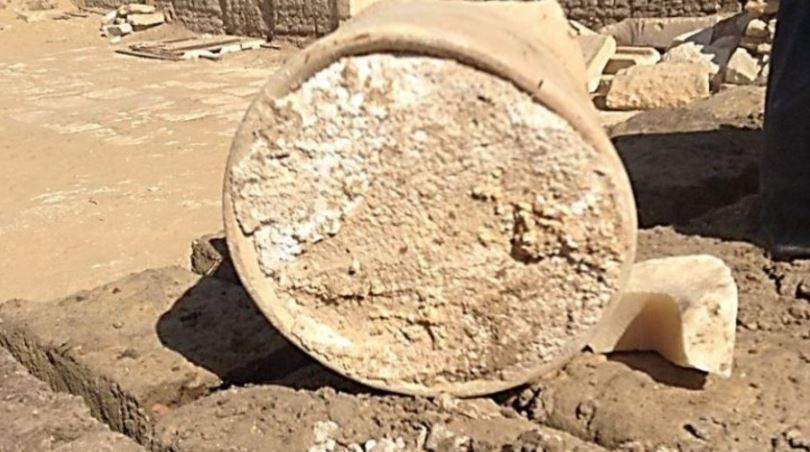
JAR BASE
The other widely reported photo is of the Broken jar also, however it has been posted "upside down". I have corrected this and hopefully here you will see the broken vessel how it should look.
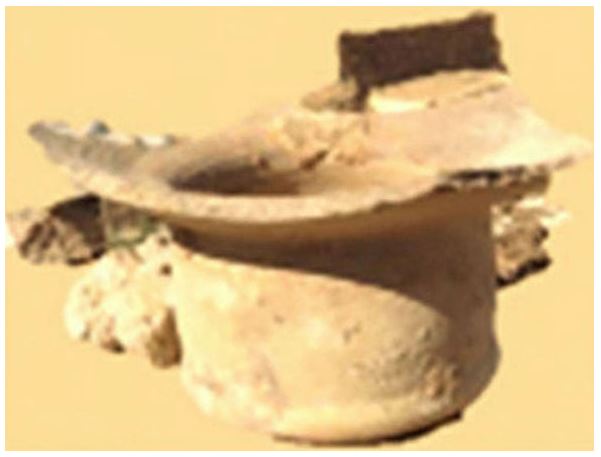
Correct side up
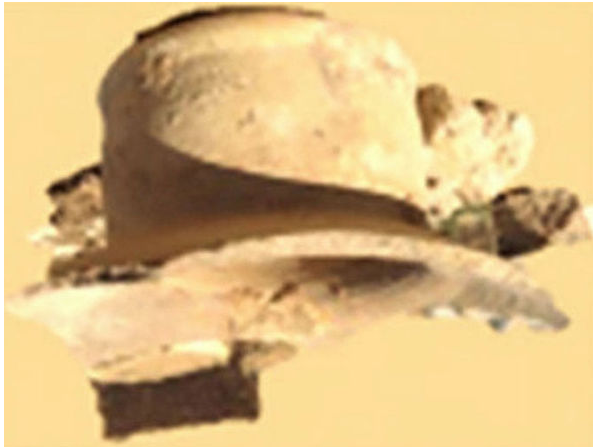
Incorrect way around
The granular "stuff" everybody keeps referring to as cheese, is not cheese folks. That was found in a sack/hessian type bag.The sandy colored granular stuff is sand and earth stuck to the base (or top, who knows....it's broken) of the Jar.

The shot everyone is seeing and has been pictured countless times in media around the world is the base of the jar.

JAR BASE
The other widely reported photo is of the Broken jar also, however it has been posted "upside down". I have corrected this and hopefully here you will see the broken vessel how it should look.

Correct side up

Incorrect way around
The granular "stuff" everybody keeps referring to as cheese, is not cheese folks. That was found in a sack/hessian type bag.The sandy colored granular stuff is sand and earth stuck to the base (or top, who knows....it's broken) of the Jar.

a reply to: CaptainBeno
Here's a picture of some pillars from the tomb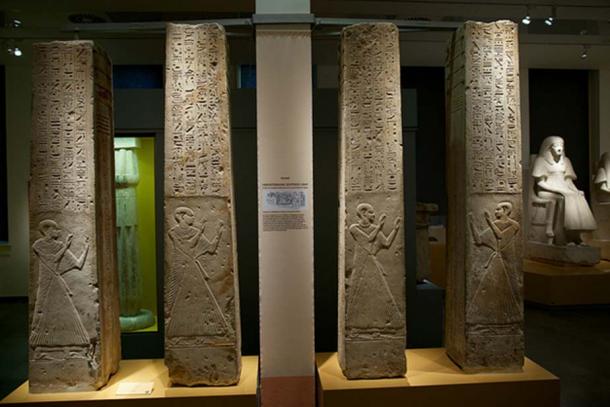
Four pillars from the Tomb of Ptahmes in the Rijksmuseum van Oudheden in Leiden, the Netherlands. ( CC BY-SA 2.0 )
I don't know if these are from the inside or outside. They are stylistically different than round columns seen in some temples.
Here's a picture of some pillars from the tomb

Four pillars from the Tomb of Ptahmes in the Rijksmuseum van Oudheden in Leiden, the Netherlands. ( CC BY-SA 2.0 )
I don't know if these are from the inside or outside. They are stylistically different than round columns seen in some temples.
a reply to: Byrd
Thanks for answering my question.
I'm always amazed when I consider the longevity of Ramesses the Great in the context of such a limited life expectancy. His 90 years is more than twice that of his contemporaries!
I believe that it is unlikely this longevity ratio scales linearly with modern day life expectancy. However, if it did, then Ramesses would live to be over 140 years old!
To what do you attribute his long lifespan?
-dex
Thanks for answering my question.
Remember that the AVERAGE life expectancy back then was around 35-40 years
I'm always amazed when I consider the longevity of Ramesses the Great in the context of such a limited life expectancy. His 90 years is more than twice that of his contemporaries!
I believe that it is unlikely this longevity ratio scales linearly with modern day life expectancy. However, if it did, then Ramesses would live to be over 140 years old!
To what do you attribute his long lifespan?
-dex
new topics
-
Weinstein's conviction overturned
Mainstream News: 7 minutes ago -
Supreme Court Oral Arguments 4.25.2024 - Are PRESIDENTS IMMUNE From Later Being Prosecuted.
Above Politics: 1 hours ago -
Krystalnacht on today's most elite Universities?
Social Issues and Civil Unrest: 1 hours ago -
Chris Christie Wishes Death Upon Trump and Ramaswamy
Politicians & People: 2 hours ago -
University of Texas Instantly Shuts Down Anti Israel Protests
Education and Media: 4 hours ago -
Any one suspicious of fever promotions events, major investor Goldman Sachs card only.
The Gray Area: 6 hours ago -
God's Righteousness is Greater than Our Wrath
Religion, Faith, And Theology: 10 hours ago
top topics
-
VP's Secret Service agent brawls with other agents at Andrews
Mainstream News: 15 hours ago, 11 flags -
Nearly 70% Of Americans Want Talks To End War In Ukraine
Political Issues: 16 hours ago, 6 flags -
Sunak spinning the sickness figures
Other Current Events: 16 hours ago, 5 flags -
Krystalnacht on today's most elite Universities?
Social Issues and Civil Unrest: 1 hours ago, 5 flags -
Electrical tricks for saving money
Education and Media: 14 hours ago, 4 flags -
Supreme Court Oral Arguments 4.25.2024 - Are PRESIDENTS IMMUNE From Later Being Prosecuted.
Above Politics: 1 hours ago, 4 flags -
University of Texas Instantly Shuts Down Anti Israel Protests
Education and Media: 4 hours ago, 2 flags -
Any one suspicious of fever promotions events, major investor Goldman Sachs card only.
The Gray Area: 6 hours ago, 2 flags -
Weinstein's conviction overturned
Mainstream News: 7 minutes ago, 2 flags -
Chris Christie Wishes Death Upon Trump and Ramaswamy
Politicians & People: 2 hours ago, 1 flags
active topics
-
Weinstein's conviction overturned
Mainstream News • 6 • : SchrodingersRat -
University of Texas Instantly Shuts Down Anti Israel Protests
Education and Media • 94 • : CriticalStinker -
Supreme Court Oral Arguments 4.25.2024 - Are PRESIDENTS IMMUNE From Later Being Prosecuted.
Above Politics • 9 • : Vermilion -
Candidate TRUMP Now Has Crazy Judge JUAN MERCHAN After Him - The Stormy Daniels Hush-Money Case.
Political Conspiracies • 746 • : matafuchs -
Chris Christie Wishes Death Upon Trump and Ramaswamy
Politicians & People • 7 • : underpass61 -
President BIDEN Vows to Make Americans Pay More Federal Taxes in 2025 - Political Suicide.
2024 Elections • 143 • : SchrodingersRat -
SETI chief says US has no evidence for alien technology. 'And we never have'
Aliens and UFOs • 65 • : andy06shake -
Sunak spinning the sickness figures
Other Current Events • 18 • : andy06shake -
British TV Presenter Refuses To Use Guest's Preferred Pronouns
Education and Media • 155 • : Annee -
Nearly 70% Of Americans Want Talks To End War In Ukraine
Political Issues • 76 • : FlyersFan

